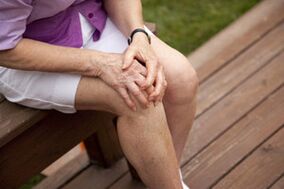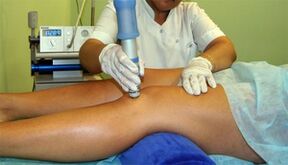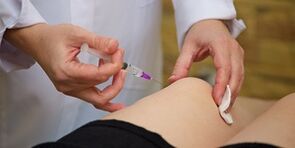
Many people complain about the pain that occurs in their knees.This may indicate the beginning of development of various diseases.The most common pathology that affects the knee joint is arthritis, commonly known as the deposition of salt.
Absolute arthritis can lead to complete destruction of cartilage and bone exposure, as well as the formation of bone plants and complete deformation of joints.This disease can turn a person into a disabled person.We will try to figure out what diseases these are, their symptoms and treatments are.
What is knee joint
A person's large beret and femur in the knee joint are covered with articular cartilage.There is also a second type of cartilage that forms domain angles and acts as a shock absorber or layer.
Articular fluid provides smooth movement and additional protection.It happens when joint development occursCarrying tissue damage, protect the surface of the bones and gradually reduce the production of joint lubrication.At the same time, partial cartridges and total losses may occur.
The manifestation of a deformed knee joint is accompanied by the destruction of its cartilage shell, and after a period of time nearby bones and ligaments can be attracted to the process.Due to the loss of cartilageFlip increases, joint deformation.
Sometimes, from the outside, you can even feel the bone spurs, which are the pathological growth of the bone.By chanceDeformation of the surface of the bone, and they can't close the way they expected, and then one has restrictions on exercise.
This condition is accompanied by pain.It is especially manifested in the morning when a person who has been fixed for a long time begins to move.Finally, this greatly reduces the quality of life.
Causes of the disease

What happens to this disease?The doctor determined several reasons:
- Aging and wear of cartilage;
- Injuried;
- overweight;
- age-related changes;
- Autoimmune disease.
In the latter case, immunity begins to attack its own joint structure, causing its inflammation and destruction.An example is a disease such as rheumatoid arthritis where simultaneous damage occurs and develops disability in both joints.
In addition, it can be called the cause of cartilage deformationInsufficient blood supplyFemoral head.In this case, we are talking about sterile necrosis.Degeneration of the knee joint and displacement of the mechanical axis may be due to improper knee formation in childhood.
Symptoms of the disease
The characteristics of knee joint articulation are three developmental stages.The first stage is manifested by a weak, unpleasant feeling of pain and swelling regularly in sore spots.
In the second stage, symptoms begin to increase, tightening occurs, and exercise becomes limited.The third degree of knee jointsConstant pain feeling, while the cartilage fabric is actually destroyed.
Symptoms of the knee joint are usually manifested by pain.It may happen suddenly, but basically it develops slowly.A person immediately began to notice her after waking up.Knee pain occurs when walking on stairsWhile walking.Knee pain is also observed when changing the weather for inductively sensitive people.
Another symptom of arthritisSwelling isThis occurs due to inflammation, the accumulation of excess fluid in the knee or may be related to the formation of bone spurs.The skin in the affected areas turns red and feels very hot.If the joint is chronically inflammatory, use anti-inflammatory drugs to remove pain and edema.
In addition, the symptoms of the joint areLoss of stabilityWhen a person simply cannot bend or straighten his legs completely.The tightening that occurs is explained by the fact that the amount of synovial lubrication is reduced.This squeaking sound later appears, causing bone spurs to rub against each other while driving.
When climbing stairs or doing physical exercise,Limited action.This makes many people use crutches or walkers.
Deformation of the knee joint is a very terrible symptom of arthritis because it indicates that the joint has undergone irreversible changes, making a person a disabled person.The knees can be found or turned toward each other.

Treatment principles
After dealing with common symptoms of the disease, it is necessary to understand how it is treated.First, it should be designed to eliminate pain.
You need to know to take painkillers onlyIt only weakens the symptomsHowever, it will never affect the course of the disease, and this drug cannot restore damaged cartilage.
Treat knee joints and joints by:
- The use of non-steroid anti-inflammatory drugs can relieve pain and reduce inflammation.
- Use medications that help restore cartilage.
- Ointments and creams for deforming joints.
In some cases, surgical intervention was performed and prescribedPhysical Therapy Proceduresand physical therapy exercises.Gymnastics with this disease are greatly helpful for treatment and the attending physician should choose to practice.
Currently, most drugs haveMany side effectsAs long as you use it for a long time, the functions of the organs and systems occur.
Use non-steroidal drugs
Treatment of knee arthritis is performed through non-replacement anti-inflammatory drugs.
They help relieve pain and reduce inflammation, but long-term use of these drugs is prohibited because the resulting side effects can negatively affect the intestinal mucosa and stomach as well as the liver, kidney and cardiovascular system.
Although taking these drugs is necessary for the treatment of knee joints, they can reduce the production of proteoglycans, thereby reducing dehydration of cartilage tissue.This is why you need to get this kind of moneyStrictly follow the doctor's prescriptionOnly under his control.
Long-term use, experts recommend choosingSelective anti-inflammatory drugs, fewer side effects and have no negative effects on metabolism in cartilage.
Carbon recovery preparations
In order to nourish and repair cartilage, continuous intake of its fabric must be carried outCartilage protector.These substances are very important for people suffering from knee joints.
The positive effects they receive only occur after a long period of use (at least six months).Cartilage protectors improve the quantity and quality of synovial fluid, andHelps recoverCartilage plate.
However, despite such beneficial properties, these compounds should not be considered as fixed assets for treating knee joints.To do this, medication must be taken for at least one and a half years, and they cannot fully recover damaged cartilage.
Use creams, ointments and compression
Knee joint treatments can be used to use a variety of ointments and creams.However, this drug should only be considered as a supplement with non-replacement anti-inflammatory drugs and cartilage protectors.Ointments and face creams help relieve discomfort, swelling, pain,Improve joint mobility.
These effects are explained by the fact that these products penetrate the blood through the skin, thereby improving blood circulation in the joints, thereby accelerating metabolism and recovery in the cartilage.
Compression processing.Compared to ointments, it has a greater effect and leads to therapeutic compression.For these purposes, a tool is usually opened that penetrates the fabric well and has analgesic and anti-inflammatory effects.

Injection use
The synovial fluid in the knee joint is very sticky, so the fabrics do not rub against each other.An important component of this lubrication is hyaluronic acid, conjunctigenol, to normalize the structure of cartilage tissue.
The level of the compound in the synovial fluid of an arthritis patient is greatly reduced, so the lubricant becomes viscous and the friction is enhanced.
Injection of drugsBased on hyaluronic acidPerforming on the knee slows down the disease progression, but only half of the patients are diagnosed with arthritis and have reduced symptoms.The injection process is usually carried out for three weeks and is administered every seven days.Six months later, the procedure was carried out again.
Surgery treatment of knee joints
If the treatment has not yet brought about the appropriate effect, surgery is performed.
It can also be done if there has been an irreversible change in the knee joint.
There are two types of surgical treatment:
- Joint fixation.
- Prosthetic limb.
By fixing the joints, the joints are fixed, thus eliminating the pain.Prosthetics are a more modern approach, including the fact that with the help of a special prosthesis, a complete or partialReplace damaged joints.
Therefore, knee jointness is a sinister to its consequences, because a person can become a disabled person.If you eat correctly, you can avoid itLive a healthy lifestyleAnd control your weight.Thanks to such simple rules, you will never know the existence of the knee joints.



















